Health Variations 2 Assessment 2: Insulin Case Study (401209)
VerifiedAdded on 2022/09/15
|11
|2203
|27
Case Study
AI Summary
This case study examines the prescription and management of insulin for a 5-year-old child, Sarah, diagnosed with type 1 diabetes. It explores the pathophysiology of type 1 diabetes, the mechanism of action of insulin, and the rationale for prescribing insulin. The case study addresses the onset, peak, and duration of action of NovoRapid insulin, its administration in relation to food, and the definition, causes, symptoms, and treatment of hypoglycemia. It also covers appropriate insulin pen needle lengths and injection angles, the importance of blood glucose level (BGL) testing, and the physical and emotional challenges faced by children with type 1 diabetes. Academic references support all answers, providing a comprehensive understanding of diabetes management and care.
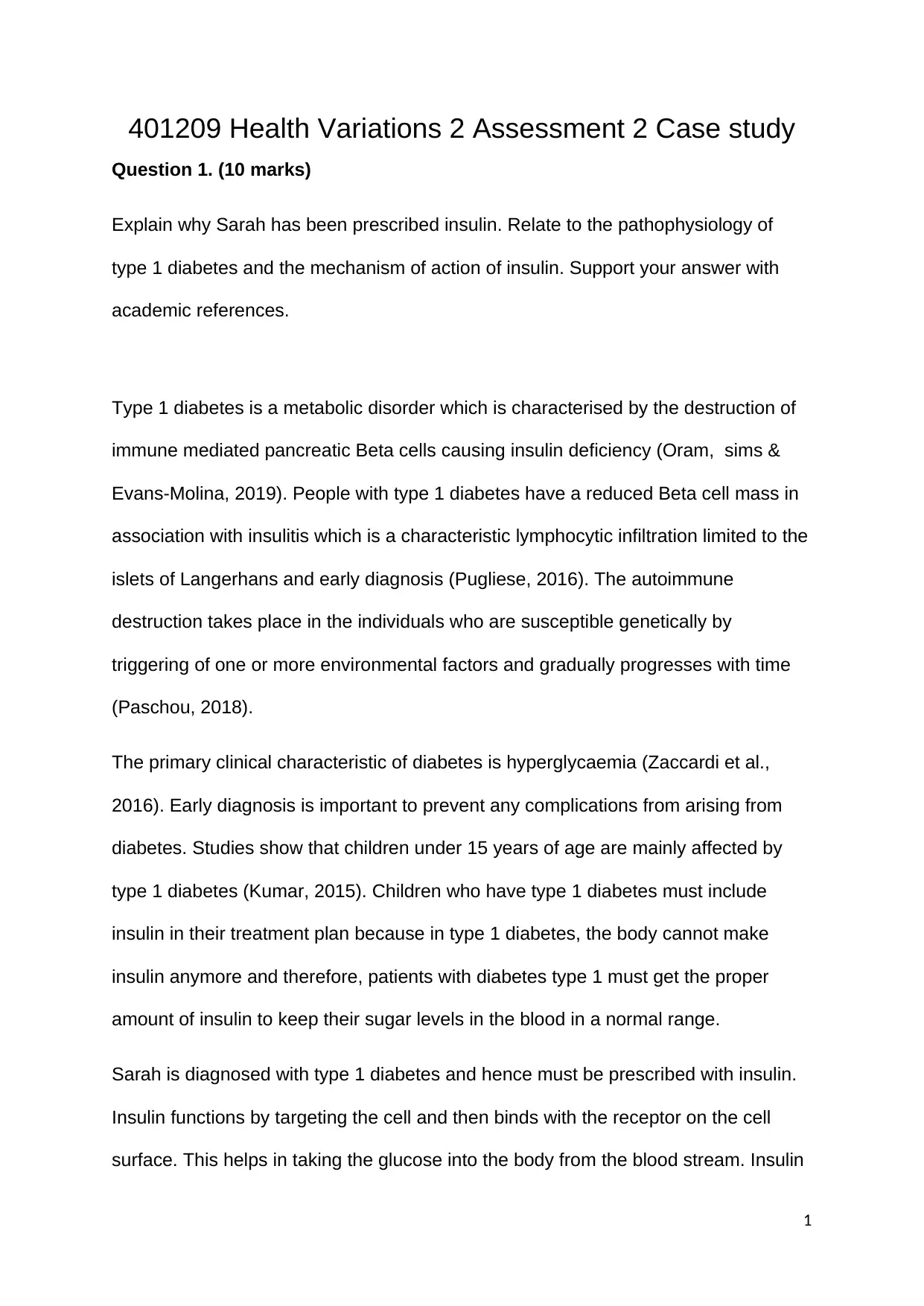
401209 Health Variations 2 Assessment 2 Case study
Question 1. (10 marks)
Explain why Sarah has been prescribed insulin. Relate to the pathophysiology of
type 1 diabetes and the mechanism of action of insulin. Support your answer with
academic references.
Type 1 diabetes is a metabolic disorder which is characterised by the destruction of
immune mediated pancreatic Beta cells causing insulin deficiency (Oram, sims &
Evans-Molina, 2019). People with type 1 diabetes have a reduced Beta cell mass in
association with insulitis which is a characteristic lymphocytic infiltration limited to the
islets of Langerhans and early diagnosis (Pugliese, 2016). The autoimmune
destruction takes place in the individuals who are susceptible genetically by
triggering of one or more environmental factors and gradually progresses with time
(Paschou, 2018).
The primary clinical characteristic of diabetes is hyperglycaemia (Zaccardi et al.,
2016). Early diagnosis is important to prevent any complications from arising from
diabetes. Studies show that children under 15 years of age are mainly affected by
type 1 diabetes (Kumar, 2015). Children who have type 1 diabetes must include
insulin in their treatment plan because in type 1 diabetes, the body cannot make
insulin anymore and therefore, patients with diabetes type 1 must get the proper
amount of insulin to keep their sugar levels in the blood in a normal range.
Sarah is diagnosed with type 1 diabetes and hence must be prescribed with insulin.
Insulin functions by targeting the cell and then binds with the receptor on the cell
surface. This helps in taking the glucose into the body from the blood stream. Insulin
1
Question 1. (10 marks)
Explain why Sarah has been prescribed insulin. Relate to the pathophysiology of
type 1 diabetes and the mechanism of action of insulin. Support your answer with
academic references.
Type 1 diabetes is a metabolic disorder which is characterised by the destruction of
immune mediated pancreatic Beta cells causing insulin deficiency (Oram, sims &
Evans-Molina, 2019). People with type 1 diabetes have a reduced Beta cell mass in
association with insulitis which is a characteristic lymphocytic infiltration limited to the
islets of Langerhans and early diagnosis (Pugliese, 2016). The autoimmune
destruction takes place in the individuals who are susceptible genetically by
triggering of one or more environmental factors and gradually progresses with time
(Paschou, 2018).
The primary clinical characteristic of diabetes is hyperglycaemia (Zaccardi et al.,
2016). Early diagnosis is important to prevent any complications from arising from
diabetes. Studies show that children under 15 years of age are mainly affected by
type 1 diabetes (Kumar, 2015). Children who have type 1 diabetes must include
insulin in their treatment plan because in type 1 diabetes, the body cannot make
insulin anymore and therefore, patients with diabetes type 1 must get the proper
amount of insulin to keep their sugar levels in the blood in a normal range.
Sarah is diagnosed with type 1 diabetes and hence must be prescribed with insulin.
Insulin functions by targeting the cell and then binds with the receptor on the cell
surface. This helps in taking the glucose into the body from the blood stream. Insulin
1
Paraphrase This Document
Need a fresh take? Get an instant paraphrase of this document with our AI Paraphraser
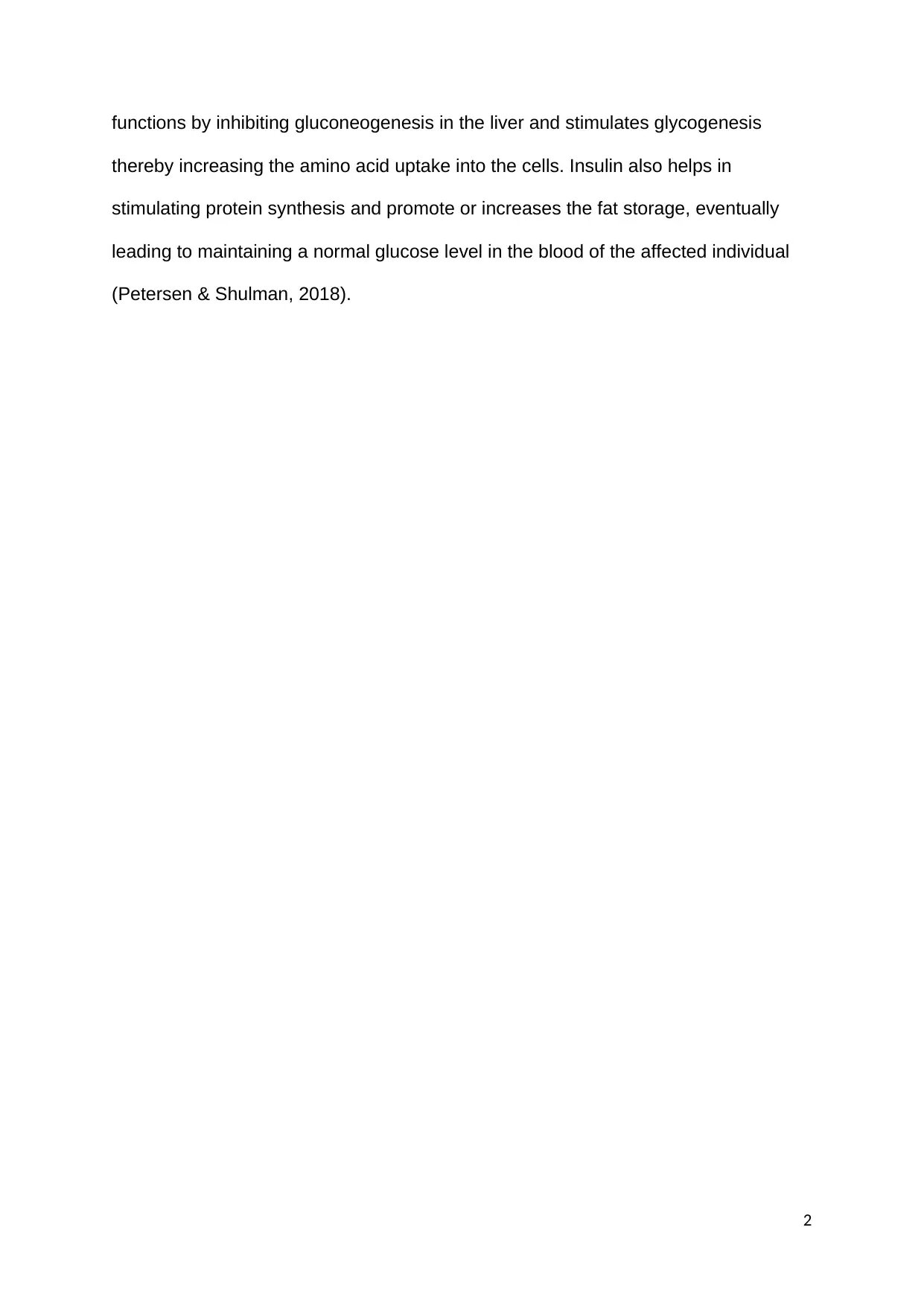
functions by inhibiting gluconeogenesis in the liver and stimulates glycogenesis
thereby increasing the amino acid uptake into the cells. Insulin also helps in
stimulating protein synthesis and promote or increases the fat storage, eventually
leading to maintaining a normal glucose level in the blood of the affected individual
(Petersen & Shulman, 2018).
2
thereby increasing the amino acid uptake into the cells. Insulin also helps in
stimulating protein synthesis and promote or increases the fat storage, eventually
leading to maintaining a normal glucose level in the blood of the affected individual
(Petersen & Shulman, 2018).
2
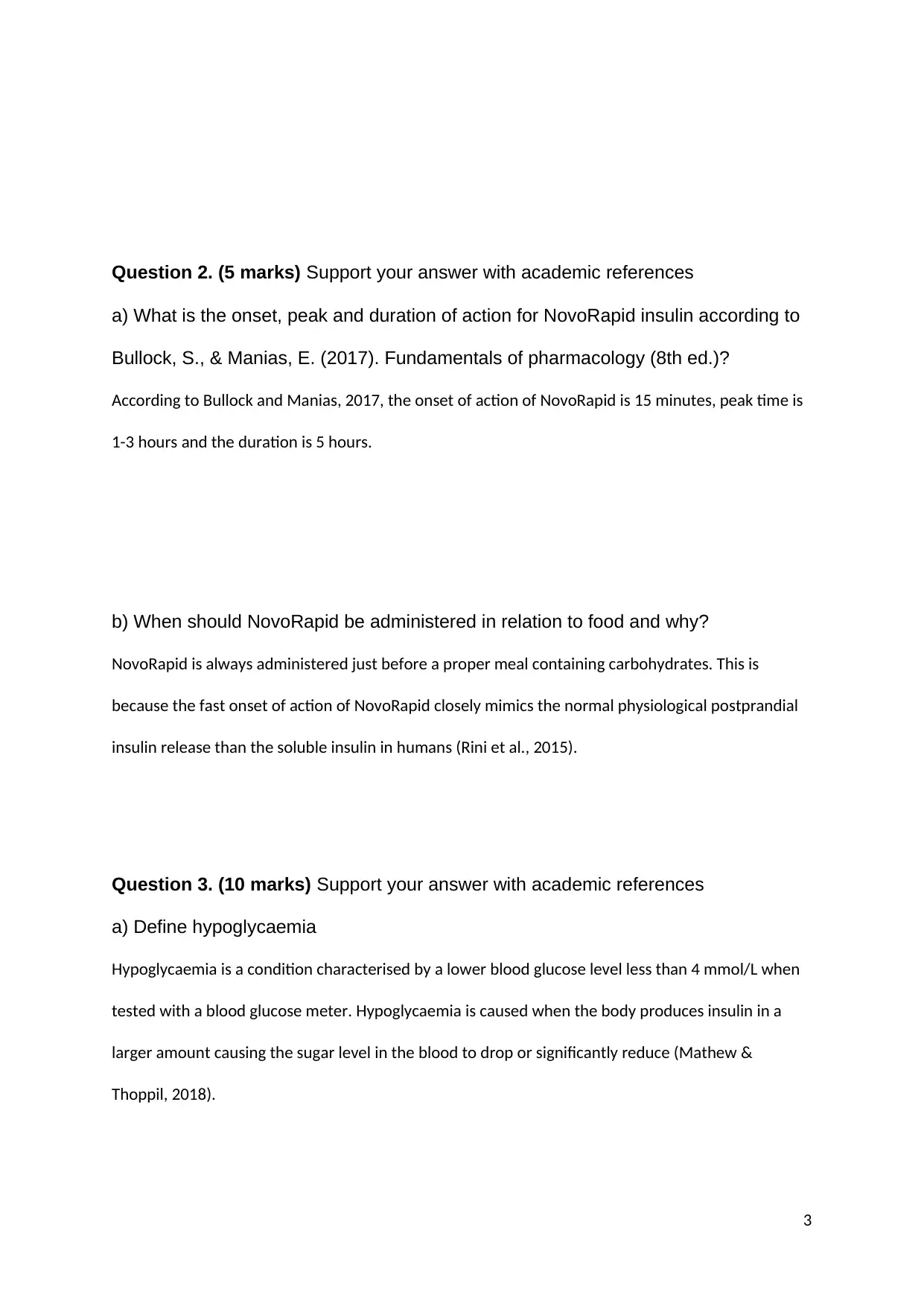
Question 2. (5 marks) Support your answer with academic references
a) What is the onset, peak and duration of action for NovoRapid insulin according to
Bullock, S., & Manias, E. (2017). Fundamentals of pharmacology (8th ed.)?
According to Bullock and Manias, 2017, the onset of action of NovoRapid is 15 minutes, peak time is
1-3 hours and the duration is 5 hours.
b) When should NovoRapid be administered in relation to food and why?
NovoRapid is always administered just before a proper meal containing carbohydrates. This is
because the fast onset of action of NovoRapid closely mimics the normal physiological postprandial
insulin release than the soluble insulin in humans (Rini et al., 2015).
Question 3. (10 marks) Support your answer with academic references
a) Define hypoglycaemia
Hypoglycaemia is a condition characterised by a lower blood glucose level less than 4 mmol/L when
tested with a blood glucose meter. Hypoglycaemia is caused when the body produces insulin in a
larger amount causing the sugar level in the blood to drop or significantly reduce (Mathew &
Thoppil, 2018).
3
a) What is the onset, peak and duration of action for NovoRapid insulin according to
Bullock, S., & Manias, E. (2017). Fundamentals of pharmacology (8th ed.)?
According to Bullock and Manias, 2017, the onset of action of NovoRapid is 15 minutes, peak time is
1-3 hours and the duration is 5 hours.
b) When should NovoRapid be administered in relation to food and why?
NovoRapid is always administered just before a proper meal containing carbohydrates. This is
because the fast onset of action of NovoRapid closely mimics the normal physiological postprandial
insulin release than the soluble insulin in humans (Rini et al., 2015).
Question 3. (10 marks) Support your answer with academic references
a) Define hypoglycaemia
Hypoglycaemia is a condition characterised by a lower blood glucose level less than 4 mmol/L when
tested with a blood glucose meter. Hypoglycaemia is caused when the body produces insulin in a
larger amount causing the sugar level in the blood to drop or significantly reduce (Mathew &
Thoppil, 2018).
3
⊘ This is a preview!⊘
Do you want full access?
Subscribe today to unlock all pages.

Trusted by 1+ million students worldwide
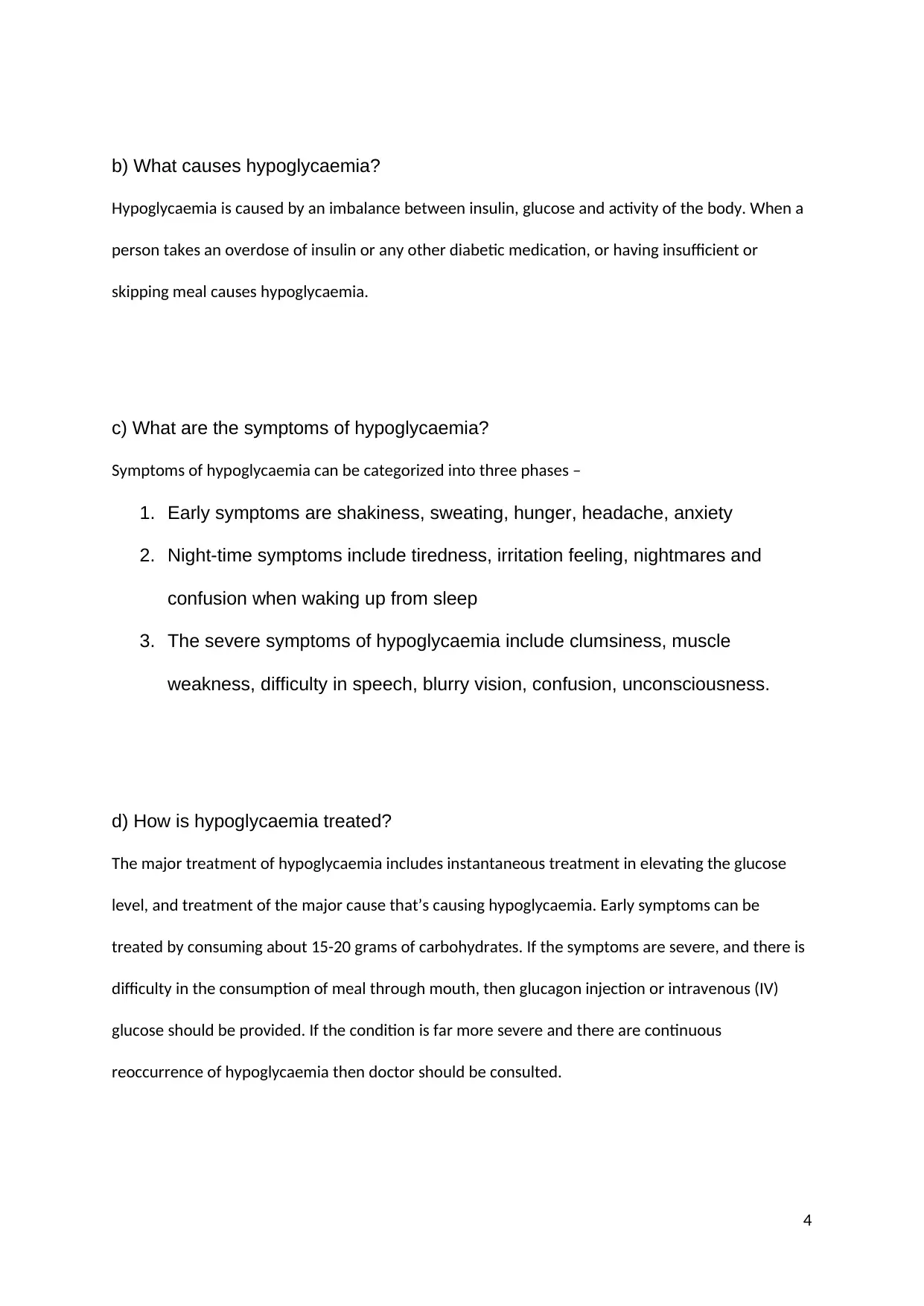
b) What causes hypoglycaemia?
Hypoglycaemia is caused by an imbalance between insulin, glucose and activity of the body. When a
person takes an overdose of insulin or any other diabetic medication, or having insufficient or
skipping meal causes hypoglycaemia.
c) What are the symptoms of hypoglycaemia?
Symptoms of hypoglycaemia can be categorized into three phases –
1. Early symptoms are shakiness, sweating, hunger, headache, anxiety
2. Night-time symptoms include tiredness, irritation feeling, nightmares and
confusion when waking up from sleep
3. The severe symptoms of hypoglycaemia include clumsiness, muscle
weakness, difficulty in speech, blurry vision, confusion, unconsciousness.
d) How is hypoglycaemia treated?
The major treatment of hypoglycaemia includes instantaneous treatment in elevating the glucose
level, and treatment of the major cause that’s causing hypoglycaemia. Early symptoms can be
treated by consuming about 15-20 grams of carbohydrates. If the symptoms are severe, and there is
difficulty in the consumption of meal through mouth, then glucagon injection or intravenous (IV)
glucose should be provided. If the condition is far more severe and there are continuous
reoccurrence of hypoglycaemia then doctor should be consulted.
4
Hypoglycaemia is caused by an imbalance between insulin, glucose and activity of the body. When a
person takes an overdose of insulin or any other diabetic medication, or having insufficient or
skipping meal causes hypoglycaemia.
c) What are the symptoms of hypoglycaemia?
Symptoms of hypoglycaemia can be categorized into three phases –
1. Early symptoms are shakiness, sweating, hunger, headache, anxiety
2. Night-time symptoms include tiredness, irritation feeling, nightmares and
confusion when waking up from sleep
3. The severe symptoms of hypoglycaemia include clumsiness, muscle
weakness, difficulty in speech, blurry vision, confusion, unconsciousness.
d) How is hypoglycaemia treated?
The major treatment of hypoglycaemia includes instantaneous treatment in elevating the glucose
level, and treatment of the major cause that’s causing hypoglycaemia. Early symptoms can be
treated by consuming about 15-20 grams of carbohydrates. If the symptoms are severe, and there is
difficulty in the consumption of meal through mouth, then glucagon injection or intravenous (IV)
glucose should be provided. If the condition is far more severe and there are continuous
reoccurrence of hypoglycaemia then doctor should be consulted.
4
Paraphrase This Document
Need a fresh take? Get an instant paraphrase of this document with our AI Paraphraser
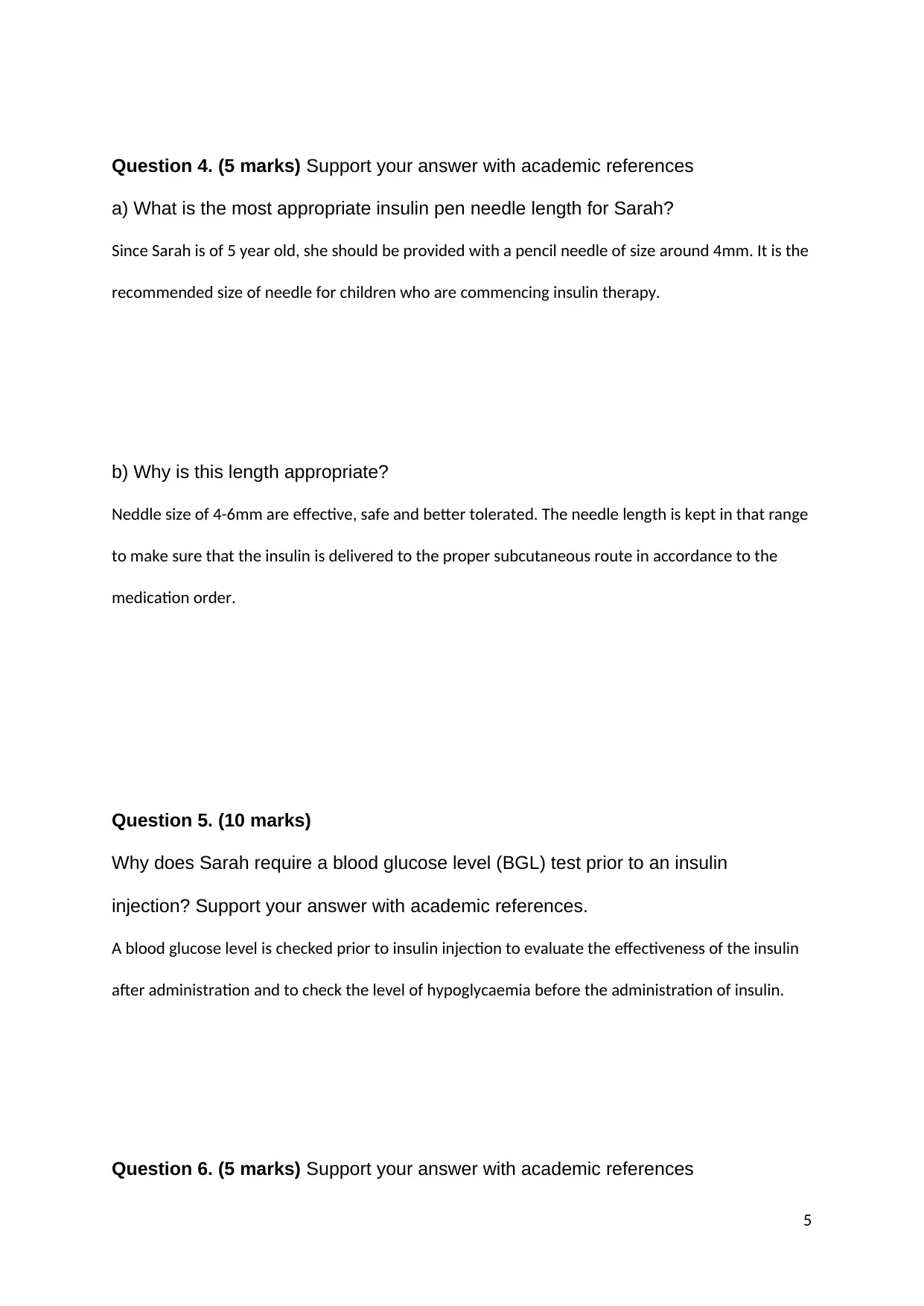
Question 4. (5 marks) Support your answer with academic references
a) What is the most appropriate insulin pen needle length for Sarah?
Since Sarah is of 5 year old, she should be provided with a pencil needle of size around 4mm. It is the
recommended size of needle for children who are commencing insulin therapy.
b) Why is this length appropriate?
Neddle size of 4-6mm are effective, safe and better tolerated. The needle length is kept in that range
to make sure that the insulin is delivered to the proper subcutaneous route in accordance to the
medication order.
Question 5. (10 marks)
Why does Sarah require a blood glucose level (BGL) test prior to an insulin
injection? Support your answer with academic references.
A blood glucose level is checked prior to insulin injection to evaluate the effectiveness of the insulin
after administration and to check the level of hypoglycaemia before the administration of insulin.
Question 6. (5 marks) Support your answer with academic references
5
a) What is the most appropriate insulin pen needle length for Sarah?
Since Sarah is of 5 year old, she should be provided with a pencil needle of size around 4mm. It is the
recommended size of needle for children who are commencing insulin therapy.
b) Why is this length appropriate?
Neddle size of 4-6mm are effective, safe and better tolerated. The needle length is kept in that range
to make sure that the insulin is delivered to the proper subcutaneous route in accordance to the
medication order.
Question 5. (10 marks)
Why does Sarah require a blood glucose level (BGL) test prior to an insulin
injection? Support your answer with academic references.
A blood glucose level is checked prior to insulin injection to evaluate the effectiveness of the insulin
after administration and to check the level of hypoglycaemia before the administration of insulin.
Question 6. (5 marks) Support your answer with academic references
5
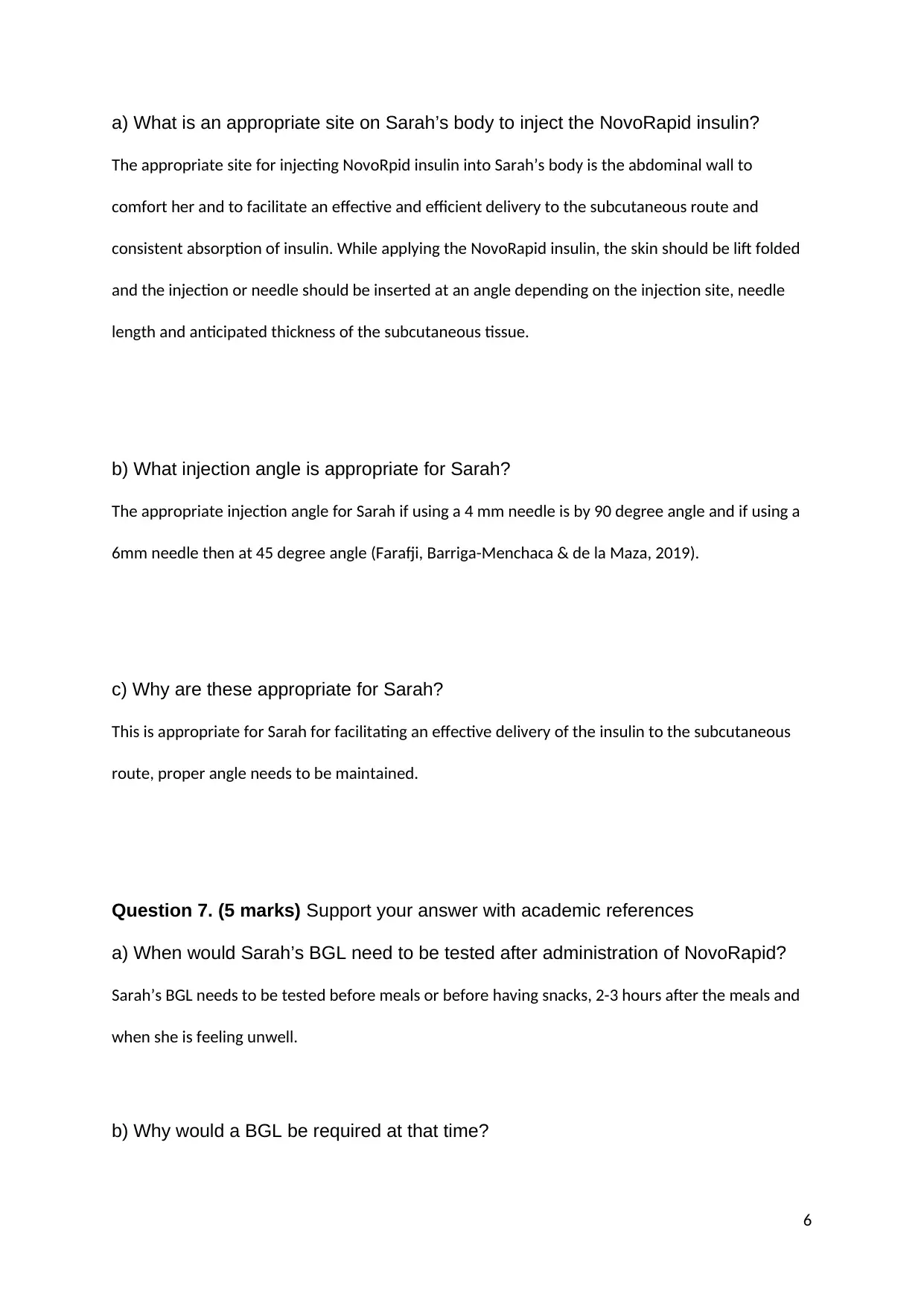
a) What is an appropriate site on Sarah’s body to inject the NovoRapid insulin?
The appropriate site for injecting NovoRpid insulin into Sarah’s body is the abdominal wall to
comfort her and to facilitate an effective and efficient delivery to the subcutaneous route and
consistent absorption of insulin. While applying the NovoRapid insulin, the skin should be lift folded
and the injection or needle should be inserted at an angle depending on the injection site, needle
length and anticipated thickness of the subcutaneous tissue.
b) What injection angle is appropriate for Sarah?
The appropriate injection angle for Sarah if using a 4 mm needle is by 90 degree angle and if using a
6mm needle then at 45 degree angle (Farafji, Barriga-Menchaca & de la Maza, 2019).
c) Why are these appropriate for Sarah?
This is appropriate for Sarah for facilitating an effective delivery of the insulin to the subcutaneous
route, proper angle needs to be maintained.
Question 7. (5 marks) Support your answer with academic references
a) When would Sarah’s BGL need to be tested after administration of NovoRapid?
Sarah’s BGL needs to be tested before meals or before having snacks, 2-3 hours after the meals and
when she is feeling unwell.
b) Why would a BGL be required at that time?
6
The appropriate site for injecting NovoRpid insulin into Sarah’s body is the abdominal wall to
comfort her and to facilitate an effective and efficient delivery to the subcutaneous route and
consistent absorption of insulin. While applying the NovoRapid insulin, the skin should be lift folded
and the injection or needle should be inserted at an angle depending on the injection site, needle
length and anticipated thickness of the subcutaneous tissue.
b) What injection angle is appropriate for Sarah?
The appropriate injection angle for Sarah if using a 4 mm needle is by 90 degree angle and if using a
6mm needle then at 45 degree angle (Farafji, Barriga-Menchaca & de la Maza, 2019).
c) Why are these appropriate for Sarah?
This is appropriate for Sarah for facilitating an effective delivery of the insulin to the subcutaneous
route, proper angle needs to be maintained.
Question 7. (5 marks) Support your answer with academic references
a) When would Sarah’s BGL need to be tested after administration of NovoRapid?
Sarah’s BGL needs to be tested before meals or before having snacks, 2-3 hours after the meals and
when she is feeling unwell.
b) Why would a BGL be required at that time?
6
⊘ This is a preview!⊘
Do you want full access?
Subscribe today to unlock all pages.

Trusted by 1+ million students worldwide
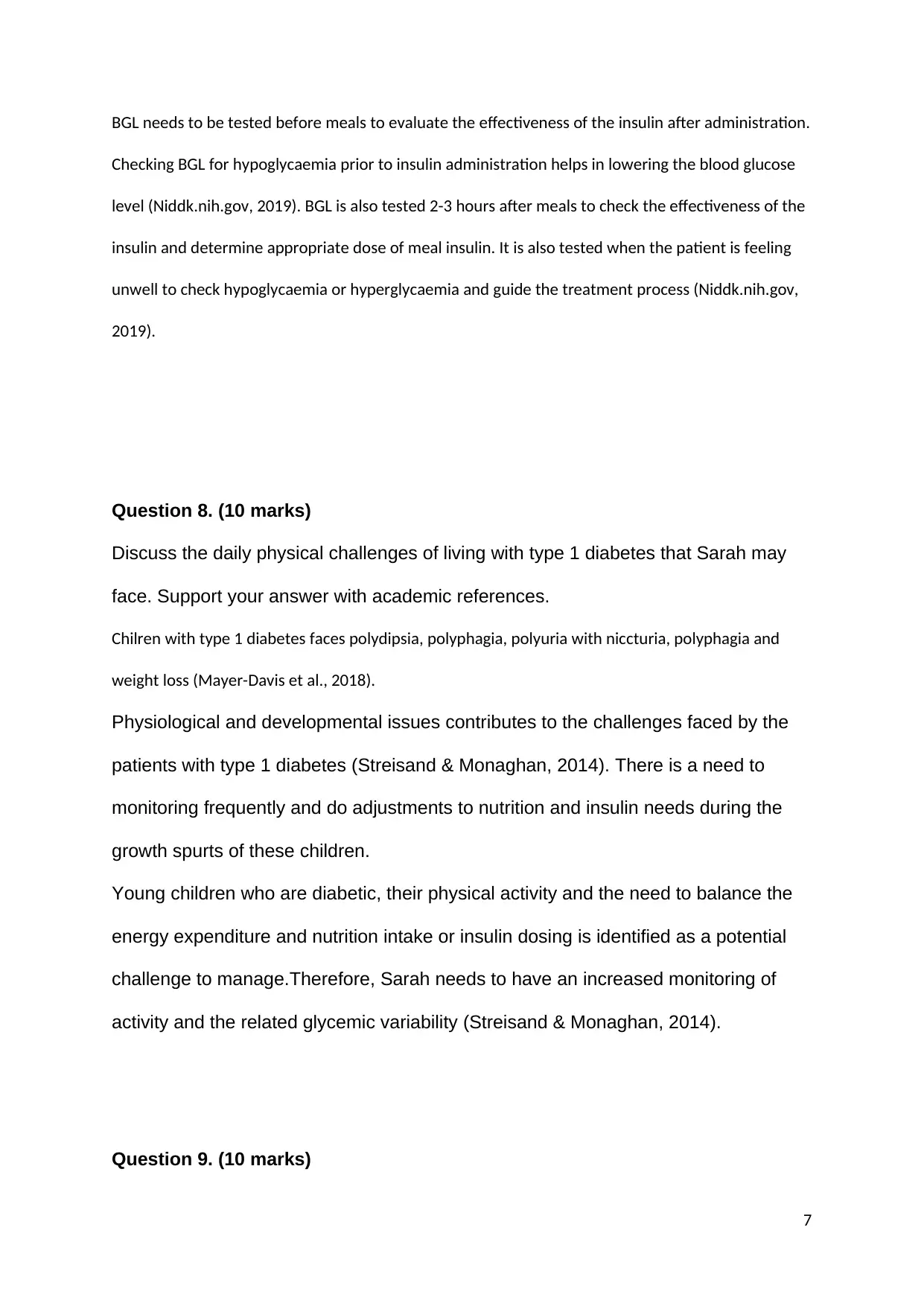
BGL needs to be tested before meals to evaluate the effectiveness of the insulin after administration.
Checking BGL for hypoglycaemia prior to insulin administration helps in lowering the blood glucose
level (Niddk.nih.gov, 2019). BGL is also tested 2-3 hours after meals to check the effectiveness of the
insulin and determine appropriate dose of meal insulin. It is also tested when the patient is feeling
unwell to check hypoglycaemia or hyperglycaemia and guide the treatment process (Niddk.nih.gov,
2019).
Question 8. (10 marks)
Discuss the daily physical challenges of living with type 1 diabetes that Sarah may
face. Support your answer with academic references.
Chilren with type 1 diabetes faces polydipsia, polyphagia, polyuria with niccturia, polyphagia and
weight loss (Mayer-Davis et al., 2018).
Physiological and developmental issues contributes to the challenges faced by the
patients with type 1 diabetes (Streisand & Monaghan, 2014). There is a need to
monitoring frequently and do adjustments to nutrition and insulin needs during the
growth spurts of these children.
Young children who are diabetic, their physical activity and the need to balance the
energy expenditure and nutrition intake or insulin dosing is identified as a potential
challenge to manage.Therefore, Sarah needs to have an increased monitoring of
activity and the related glycemic variability (Streisand & Monaghan, 2014).
Question 9. (10 marks)
7
Checking BGL for hypoglycaemia prior to insulin administration helps in lowering the blood glucose
level (Niddk.nih.gov, 2019). BGL is also tested 2-3 hours after meals to check the effectiveness of the
insulin and determine appropriate dose of meal insulin. It is also tested when the patient is feeling
unwell to check hypoglycaemia or hyperglycaemia and guide the treatment process (Niddk.nih.gov,
2019).
Question 8. (10 marks)
Discuss the daily physical challenges of living with type 1 diabetes that Sarah may
face. Support your answer with academic references.
Chilren with type 1 diabetes faces polydipsia, polyphagia, polyuria with niccturia, polyphagia and
weight loss (Mayer-Davis et al., 2018).
Physiological and developmental issues contributes to the challenges faced by the
patients with type 1 diabetes (Streisand & Monaghan, 2014). There is a need to
monitoring frequently and do adjustments to nutrition and insulin needs during the
growth spurts of these children.
Young children who are diabetic, their physical activity and the need to balance the
energy expenditure and nutrition intake or insulin dosing is identified as a potential
challenge to manage.Therefore, Sarah needs to have an increased monitoring of
activity and the related glycemic variability (Streisand & Monaghan, 2014).
Question 9. (10 marks)
7
Paraphrase This Document
Need a fresh take? Get an instant paraphrase of this document with our AI Paraphraser
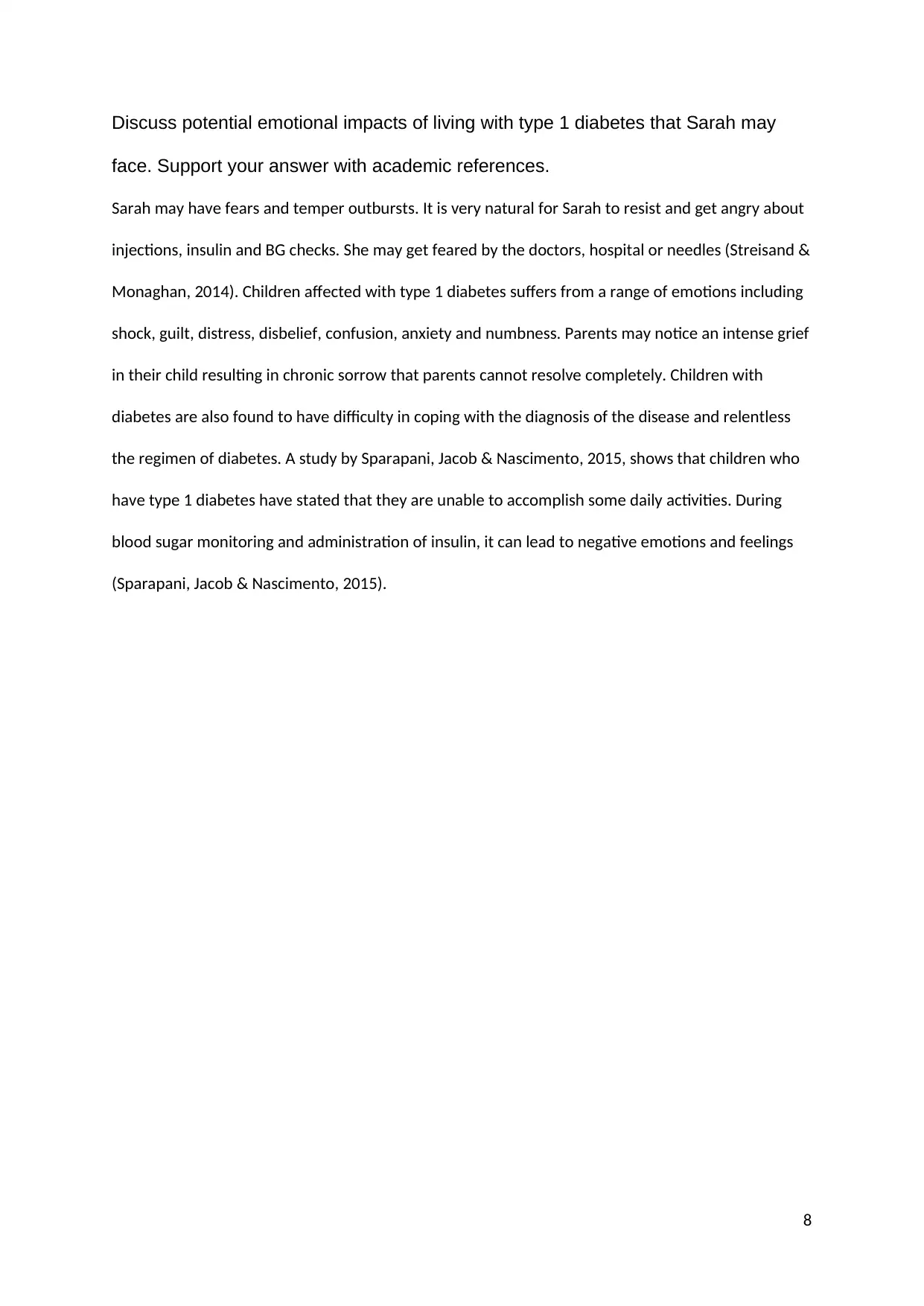
Discuss potential emotional impacts of living with type 1 diabetes that Sarah may
face. Support your answer with academic references.
Sarah may have fears and temper outbursts. It is very natural for Sarah to resist and get angry about
injections, insulin and BG checks. She may get feared by the doctors, hospital or needles (Streisand &
Monaghan, 2014). Children affected with type 1 diabetes suffers from a range of emotions including
shock, guilt, distress, disbelief, confusion, anxiety and numbness. Parents may notice an intense grief
in their child resulting in chronic sorrow that parents cannot resolve completely. Children with
diabetes are also found to have difficulty in coping with the diagnosis of the disease and relentless
the regimen of diabetes. A study by Sparapani, Jacob & Nascimento, 2015, shows that children who
have type 1 diabetes have stated that they are unable to accomplish some daily activities. During
blood sugar monitoring and administration of insulin, it can lead to negative emotions and feelings
(Sparapani, Jacob & Nascimento, 2015).
8
face. Support your answer with academic references.
Sarah may have fears and temper outbursts. It is very natural for Sarah to resist and get angry about
injections, insulin and BG checks. She may get feared by the doctors, hospital or needles (Streisand &
Monaghan, 2014). Children affected with type 1 diabetes suffers from a range of emotions including
shock, guilt, distress, disbelief, confusion, anxiety and numbness. Parents may notice an intense grief
in their child resulting in chronic sorrow that parents cannot resolve completely. Children with
diabetes are also found to have difficulty in coping with the diagnosis of the disease and relentless
the regimen of diabetes. A study by Sparapani, Jacob & Nascimento, 2015, shows that children who
have type 1 diabetes have stated that they are unable to accomplish some daily activities. During
blood sugar monitoring and administration of insulin, it can lead to negative emotions and feelings
(Sparapani, Jacob & Nascimento, 2015).
8
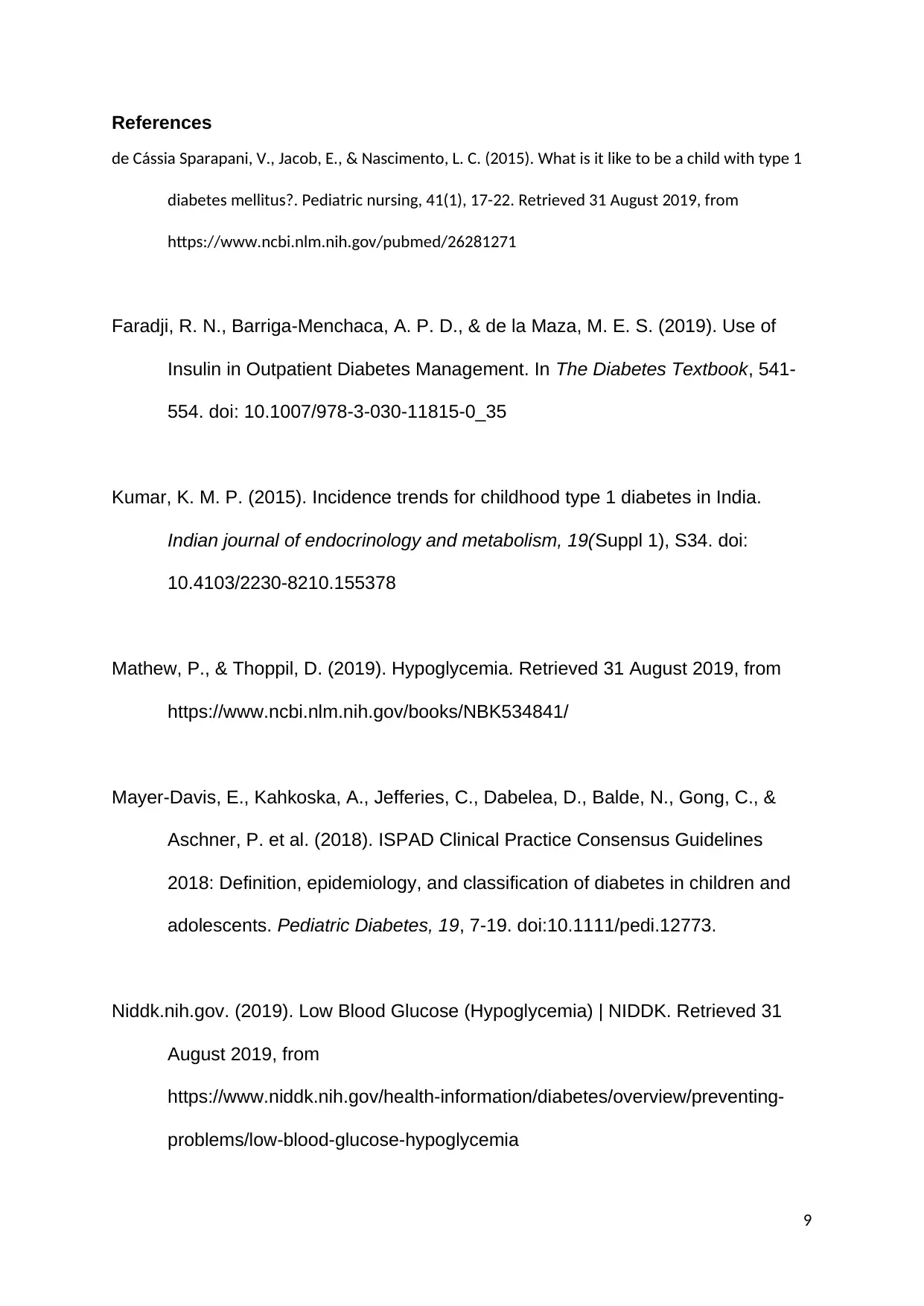
References
de Cássia Sparapani, V., Jacob, E., & Nascimento, L. C. (2015). What is it like to be a child with type 1
diabetes mellitus?. Pediatric nursing, 41(1), 17-22. Retrieved 31 August 2019, from
https://www.ncbi.nlm.nih.gov/pubmed/26281271
Faradji, R. N., Barriga-Menchaca, A. P. D., & de la Maza, M. E. S. (2019). Use of
Insulin in Outpatient Diabetes Management. In The Diabetes Textbook, 541-
554. doi: 10.1007/978-3-030-11815-0_35
Kumar, K. M. P. (2015). Incidence trends for childhood type 1 diabetes in India.
Indian journal of endocrinology and metabolism, 19(Suppl 1), S34. doi:
10.4103/2230-8210.155378
Mathew, P., & Thoppil, D. (2019). Hypoglycemia. Retrieved 31 August 2019, from
https://www.ncbi.nlm.nih.gov/books/NBK534841/
Mayer-Davis, E., Kahkoska, A., Jefferies, C., Dabelea, D., Balde, N., Gong, C., &
Aschner, P. et al. (2018). ISPAD Clinical Practice Consensus Guidelines
2018: Definition, epidemiology, and classification of diabetes in children and
adolescents. Pediatric Diabetes, 19, 7-19. doi:10.1111/pedi.12773.
Niddk.nih.gov. (2019). Low Blood Glucose (Hypoglycemia) | NIDDK. Retrieved 31
August 2019, from
https://www.niddk.nih.gov/health-information/diabetes/overview/preventing-
problems/low-blood-glucose-hypoglycemia
9
de Cássia Sparapani, V., Jacob, E., & Nascimento, L. C. (2015). What is it like to be a child with type 1
diabetes mellitus?. Pediatric nursing, 41(1), 17-22. Retrieved 31 August 2019, from
https://www.ncbi.nlm.nih.gov/pubmed/26281271
Faradji, R. N., Barriga-Menchaca, A. P. D., & de la Maza, M. E. S. (2019). Use of
Insulin in Outpatient Diabetes Management. In The Diabetes Textbook, 541-
554. doi: 10.1007/978-3-030-11815-0_35
Kumar, K. M. P. (2015). Incidence trends for childhood type 1 diabetes in India.
Indian journal of endocrinology and metabolism, 19(Suppl 1), S34. doi:
10.4103/2230-8210.155378
Mathew, P., & Thoppil, D. (2019). Hypoglycemia. Retrieved 31 August 2019, from
https://www.ncbi.nlm.nih.gov/books/NBK534841/
Mayer-Davis, E., Kahkoska, A., Jefferies, C., Dabelea, D., Balde, N., Gong, C., &
Aschner, P. et al. (2018). ISPAD Clinical Practice Consensus Guidelines
2018: Definition, epidemiology, and classification of diabetes in children and
adolescents. Pediatric Diabetes, 19, 7-19. doi:10.1111/pedi.12773.
Niddk.nih.gov. (2019). Low Blood Glucose (Hypoglycemia) | NIDDK. Retrieved 31
August 2019, from
https://www.niddk.nih.gov/health-information/diabetes/overview/preventing-
problems/low-blood-glucose-hypoglycemia
9
⊘ This is a preview!⊘
Do you want full access?
Subscribe today to unlock all pages.

Trusted by 1+ million students worldwide
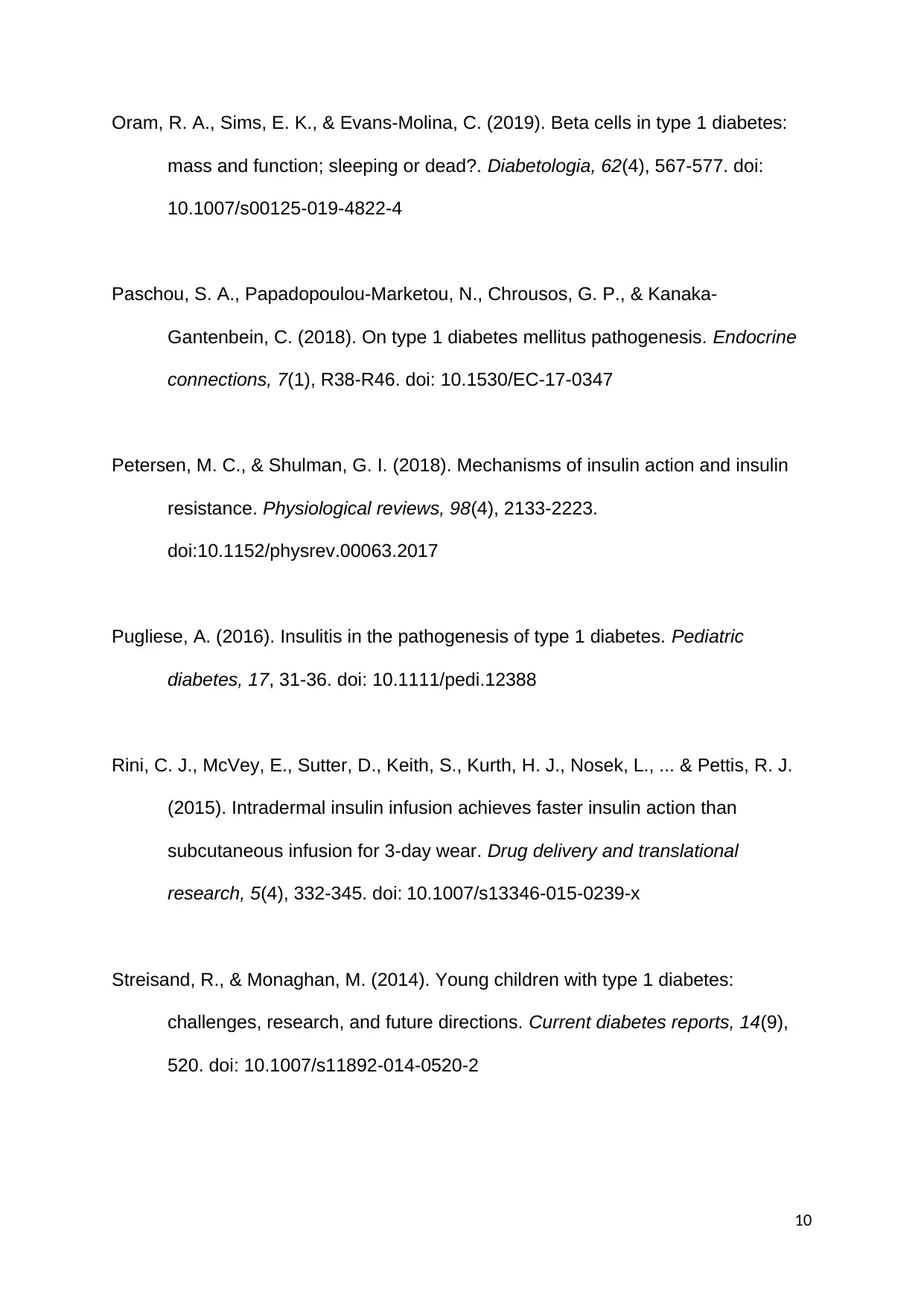
Oram, R. A., Sims, E. K., & Evans-Molina, C. (2019). Beta cells in type 1 diabetes:
mass and function; sleeping or dead?. Diabetologia, 62(4), 567-577. doi:
10.1007/s00125-019-4822-4
Paschou, S. A., Papadopoulou-Marketou, N., Chrousos, G. P., & Kanaka-
Gantenbein, C. (2018). On type 1 diabetes mellitus pathogenesis. Endocrine
connections, 7(1), R38-R46. doi: 10.1530/EC-17-0347
Petersen, M. C., & Shulman, G. I. (2018). Mechanisms of insulin action and insulin
resistance. Physiological reviews, 98(4), 2133-2223.
doi:10.1152/physrev.00063.2017
Pugliese, A. (2016). Insulitis in the pathogenesis of type 1 diabetes. Pediatric
diabetes, 17, 31-36. doi: 10.1111/pedi.12388
Rini, C. J., McVey, E., Sutter, D., Keith, S., Kurth, H. J., Nosek, L., ... & Pettis, R. J.
(2015). Intradermal insulin infusion achieves faster insulin action than
subcutaneous infusion for 3-day wear. Drug delivery and translational
research, 5(4), 332-345. doi: 10.1007/s13346-015-0239-x
Streisand, R., & Monaghan, M. (2014). Young children with type 1 diabetes:
challenges, research, and future directions. Current diabetes reports, 14(9),
520. doi: 10.1007/s11892-014-0520-2
10
mass and function; sleeping or dead?. Diabetologia, 62(4), 567-577. doi:
10.1007/s00125-019-4822-4
Paschou, S. A., Papadopoulou-Marketou, N., Chrousos, G. P., & Kanaka-
Gantenbein, C. (2018). On type 1 diabetes mellitus pathogenesis. Endocrine
connections, 7(1), R38-R46. doi: 10.1530/EC-17-0347
Petersen, M. C., & Shulman, G. I. (2018). Mechanisms of insulin action and insulin
resistance. Physiological reviews, 98(4), 2133-2223.
doi:10.1152/physrev.00063.2017
Pugliese, A. (2016). Insulitis in the pathogenesis of type 1 diabetes. Pediatric
diabetes, 17, 31-36. doi: 10.1111/pedi.12388
Rini, C. J., McVey, E., Sutter, D., Keith, S., Kurth, H. J., Nosek, L., ... & Pettis, R. J.
(2015). Intradermal insulin infusion achieves faster insulin action than
subcutaneous infusion for 3-day wear. Drug delivery and translational
research, 5(4), 332-345. doi: 10.1007/s13346-015-0239-x
Streisand, R., & Monaghan, M. (2014). Young children with type 1 diabetes:
challenges, research, and future directions. Current diabetes reports, 14(9),
520. doi: 10.1007/s11892-014-0520-2
10
Paraphrase This Document
Need a fresh take? Get an instant paraphrase of this document with our AI Paraphraser
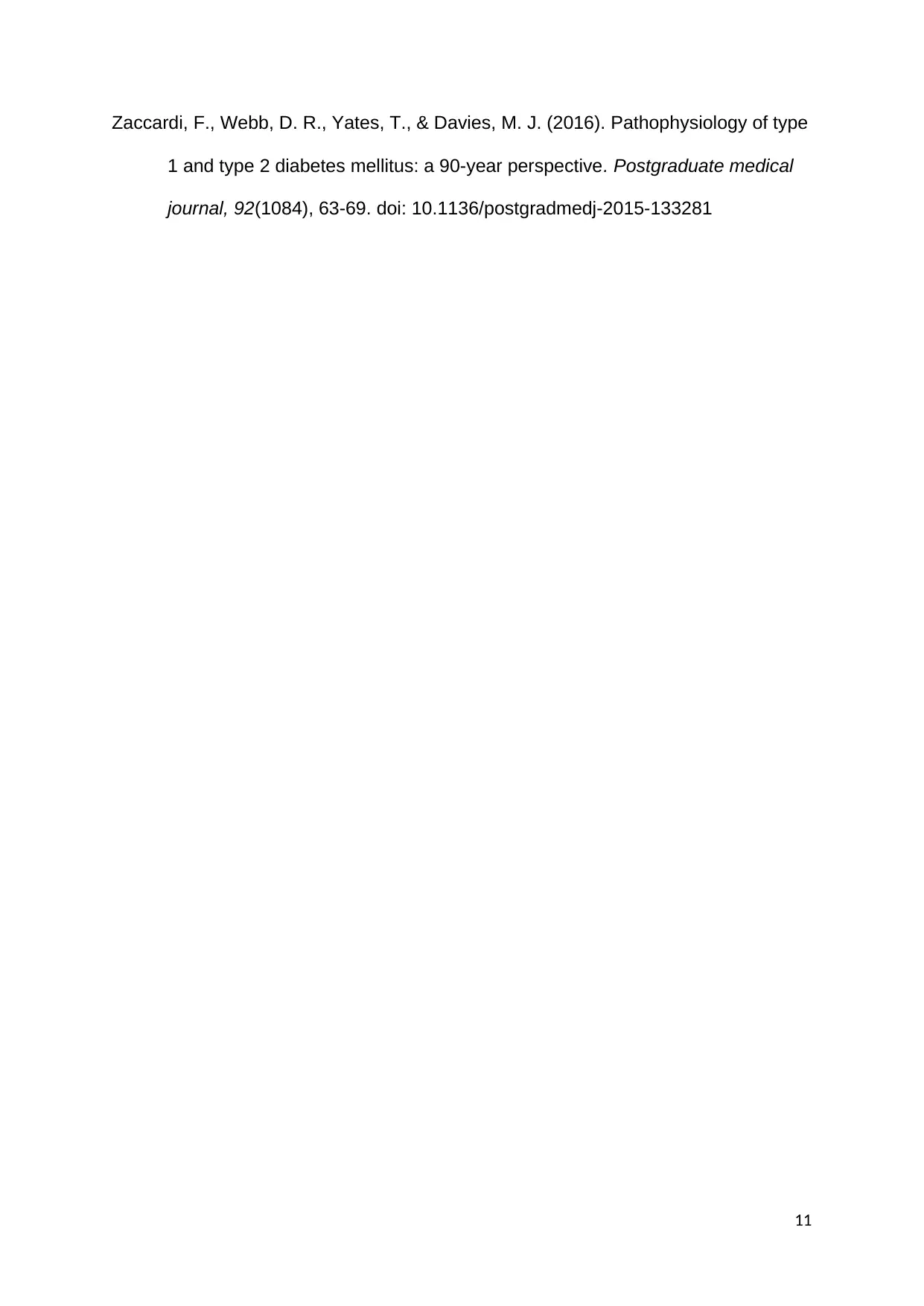
Zaccardi, F., Webb, D. R., Yates, T., & Davies, M. J. (2016). Pathophysiology of type
1 and type 2 diabetes mellitus: a 90-year perspective. Postgraduate medical
journal, 92(1084), 63-69. doi: 10.1136/postgradmedj-2015-133281
11
1 and type 2 diabetes mellitus: a 90-year perspective. Postgraduate medical
journal, 92(1084), 63-69. doi: 10.1136/postgradmedj-2015-133281
11
1 out of 11
Related Documents
Your All-in-One AI-Powered Toolkit for Academic Success.
+13062052269
info@desklib.com
Available 24*7 on WhatsApp / Email
![[object Object]](/_next/static/media/star-bottom.7253800d.svg)
Unlock your academic potential
Copyright © 2020–2025 A2Z Services. All Rights Reserved. Developed and managed by ZUCOL.




